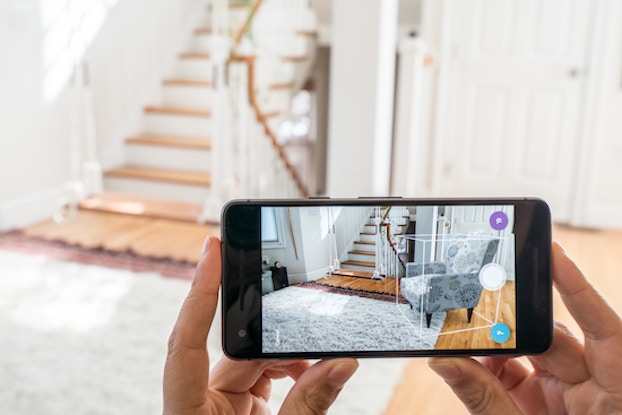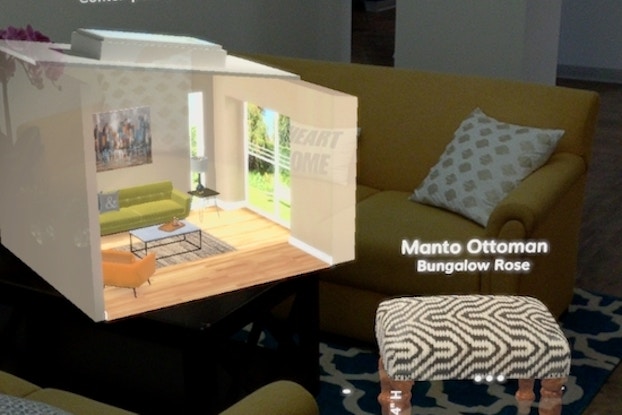
That retro wingback chair will look great in my foyer, but will it obstruct the adjacent staircase? Lady Gaga’s shades are killer, but how will her frame style look on my face? Will that bold Ruby Woo lip color clash with my skin tone?
Augmented reality (AR) delivers answers to such burning questions to convert browsers to buyers, prompting more retailers like Sephora, Ulta, Macy’s, Lowe’s and Wayfair to test and invest in the technology. Because AR overlays digital images onto real world imagery, it offers a realistic “try-before-you-buy” visual experience that assures shoppers of their purchase decisions.
A cosmetics shopper can virtually “try on” numerous lipsticks by uploading her selfie to a mobile AR app that overlays lip colors onto her image. The furniture shopper can insert a 3D digital rendering of a chair into the live view from his smartphone camera to visualize exactly how the piece will fit into the room’s physical space.
It’s this blending of digital elements with a real-world context that distinguishes augmented reality from virtual reality. Virtual reality (VR), by contrast, immerses a user completely into a digital universe, shutting out the real world.
Boston Consulting Group’s benchmarking study estimates 80 million people engage with augmented reality on a monthly basis today in the United States, a figure projected to grow to 120 million by 2021. While AR’s return-on-investment metrics can be elusive, home design website Houzz reports that consumers using its AR mobile app are 11 times more likely to make a purchase than consumers who do not use the tool.
Among AR’s pioneers is Boston’s Wayfair, the $5.7 billion online home furnishings retailer that ventured into AR in 2016 and brought it to the masses a year later with its View in Room 3Dmobile shopping app running on Apple’s ARKit AR platform. Wayfair expanded the app to Android devicesin 2018.
To use the app, consumers point their smartphone camera toward a space in their home and select a product from the online Wayfair catalog; the AR tool then overlays a 3D digital version of the selected item, such a table or chair, into the live view of that room. The true-to-scale digital renderings of furniture can be moved around and viewed from various angles with no need for a tape measure. If the chair a shopper wants to buy is a poor fit for the space, blocking an entryway or window, for example, the phone’s live camera view will reveal this.
“Information in context is a powerful tool,” said Shrenik Sadalgi, head of Next Gen Experiences at Wayfair. “Information is a lot more powerful — in context,” he added, for emphasis.
Context feeds confidence that converts shoppers to buyers because they are able to visualize how Wayfair products will fit into their own homes.
We imagine what retail would look like if spatial computing is the next computing platform, so that's why we built a home design experience.
Shrenik Sadalgi, head of Next Gen Experiences at Wayfair
Wayfair’s newest AR incarnation, an interior design app called Wayfair Spacesunveiled in October 2018, immerses shoppers more richly into the room design process – not merely selecting furnishings but choosing room decor. Using a Magic Leap VR headset (not a smartphone) in their homes, shoppers view a selection of 3D digital rooms designed by Wayfair stylists – various color schemes and design styles from contemporary to colonial – and place Wayfair furnishings into the computer-generated home space to not only furnish a room, but decorate it, too. This blending of augmented reality with virtual reality is a step toward spatial computing.
With spatial computing, your physical space becomes your "screen" where you can view anything you would normally see on a computer or phone screen. With this technology, Sadalgi told CO—, customers will be able to experience shopping for items in the Wayfair catalog by looking at them in the context of their own physical space.
“We imagine what retail would look like if spatial computing is the next computing platform, so that's why we built a home design experience. You can browse the Wayfair catalog and actually design your space using Magic Leap. It’s a demonstration of what retail would look like when spatial computing is a lot more accessible.”
Experiment with AR – without breaking the bank
Businesses eager to play with AR need not go to the expense of developing proprietary technology on their own, said Chris Baker, founder, managing director, Totem Media, a Beijing, China-based social media agency with offices in Hong Kong and Vancouver, Canada. “Facebook and Snapchat have done a nice job of surfacing opportunities for brands to cost-efficiently start experimenting, to get their heads around AR,” he told CO—.
Augmented reality investments in China outpace North America, according to Digi-Capital, a Silicon Valley-based adviser on AR and VR. China’s mobile-oriented cultureand social media focus have driven its AR advancements ahead of North America, with lessons for U.S. companies exploring AR, Baker told CO—.
“A brand is well-advised to do AR experiments only after they have a strong mobile presence and a good follower base on mobile and social,” he said. After those building blocks are in place together with a strong connection with shoppers both online and offline, he said, AR is the “digital cherry on top.”

AR — not just for commerce, but easing daily life
Apple CEO Tim Cook sees great potential for augmented reality, as he told The Independent in 2017, “I’m excited about augmented reality because unlike virtual reality, which closes the world out, AR allows individuals to be present in the world but hopefully allows an improvement on what’s happening presently. I get excited because of the things that could be done that could improve a lot of lives.”
Like Cook, Forrester Research’s Brendan Witcher, vice president and principal analyst, sees AR’s potential to enhance daily life such as directional turn arrows superimposed on a motorist’s windshield to guide navigation. Augmented reality can be a powerful educational tool for a student who shoots a photo of plant life using the Google LensAR image-recognition tool on his smartphone that identifies the species and provides additional information and related images.
“AR is huge in real estate because it gives the ability to walk through a room, hold up my phone and get dimensions of the room,” Witcher told CO—. If a home buyer is soured by a kitchen’s 1970s-era Harvest Gold color scheme, for instance, AR can create a digital rendering of how the kitchen would look blanketed in more contemporary hues like Forsythia or Fresh Butter. “Or, maybe there is not much curb appeal, so let’s add some landscaping [via AR digital images] and suddenly it looks kind of nice.”
Not just customer-facing, but operations, too
While AR’s experiential appeal will continue to grab headlines, there are less sexy applications for business worth considering, said Jon Stine, research affiliate for the MIT Auto-ID Lab at Massachusetts Institute of Technology.
“All too often I see retail-centric AR demos that focus upon consumer-facing usage,” he told CO—. “Interesting, to be sure, but painfully limited when it comes to tangible value creation.”
“I see substantial opportunity for augmented reality applications to create new efficiencies within the processes now demanded,” he said. For example, online purchases shipped from a store — or collected by consumers at a store — require staff to pack orders in a short timeframe. “How will this be done accurately and quickly?” Stine asked. “With a paper list in one hand? Or, perhaps through a wearable device that augments reality with pick-list directions?
“AR offers remarkable potential in increasing business process productivity,” Stine added. “That’s where the money is. If the AR technologists take the time to get inside the business, AR use can — and will — take off.”
CO— aims to bring you inspiration from leading respected experts. However, before making any business decision, you should consult a professional who can advise you based on your individual situation.
CO—is committed to helping you start, run and grow your small business. Learn more about the benefits of small business membership in the U.S. Chamber of Commerce, here.





